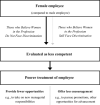In some professions, women have become well represented, yet gender bias persists-Perpetuated by those who think it is not happening
- PMID: 32637616
- PMCID: PMC7319752
- DOI: 10.1126/sciadv.aba7814
In some professions, women have become well represented, yet gender bias persists-Perpetuated by those who think it is not happening
Abstract
In efforts to promote equality and combat gender bias, traditionally male-occupied professions are investing resources into hiring more women. Looking forward, if women do become well represented in a profession, does this mean equality has been achieved? Are issues of bias resolved? Two studies including a randomized double-blind experiment demonstrate that biases persist even when women become well represented (evinced in veterinary medicine). Evidence included managers evaluating an employee randomly assigned a male (versus female) name as more competent and advising a $3475.00 higher salary, equating to an 8% pay gap. Importantly, those who thought bias was not happening in their field were the key drivers of it-a "high risk" group (including men and women) that, as shown, can be readily identified/assessed. Thus, as other professions make gains in women's representation, it is vital to recognize that discrimination can persist-perpetuated by those who think it is not happening.
Copyright © 2020 The Authors, some rights reserved; exclusive licensee American Association for the Advancement of Science. No claim to original U.S. Government Works. Distributed under a Creative Commons Attribution License 4.0 (CC BY).
Figures




References
-
- NSF National Center for Science and Engineering Statistics, Women, Minorities, and Persons with Disabilities in Science and Engineering (NSF National Center for Science and Engineering Statistics, 2019); https://ncses.nsf.gov/pubs/nsf19304/digest.
-
- U.S. Department of Labor, Women’s Bureau, Employment and Earnings by Occupation 2018 (U.S. Department of Labor, 2018); https://www.dol.gov/agencies/wb/data/occupations.
-
- B. Murphy, These Medical Specialties Have the Biggest Gender Imbalances (American Medical Association, 2019); https://ama-assn.org/residents-students/specialty-profiles/these-medical....
-
- Koch A. J., D’Mello S. D., Sackett P. R., A meta-analysis of gender stereotypes and bias in experimental simulations of employment decision making. J. Appl. Psychol. 100, 128–161 (2015). - PubMed
Publication types
LinkOut - more resources
Full Text Sources
Miscellaneous

